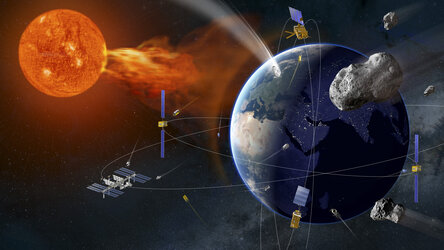N° 18–1999: ESA medals mark the Hipparcos revolution in astronomy
20 May 1999
At a gathering of top space scientists the European Space Agency's Director of Science, Roger Bonnet, today conferred medals on four European astronomers for their leading roles in the Hipparcos mission. This pioneering project in space astrometry fixed the positions of the stars far more accurately than ever before.
Catherine Turon and Jean Kovalevsky from France, Lennart Lindegren from Sweden and Erik H(g from Denmark each received a Director of Science Medal. The occasion was a meeting in Bern, Switzerland, of the Science Programme Committee, which brings together senior representatives of space science in the fourteen Member States of ESA.
The Director of Science Medal is a new award introduced to recognize extraordinary efforts and achievements by scientists and engineers from universities and research institutes who participate in ESA's space science missions. This years awards are a tribute to the contributions of scientists outside of ESA which are indispensable if the projects are not only to succeed technically but also be the best in the world, with a large payoff in discoveries.
"ESA's Director of Science's very first medals for science are awarded for work with Hipparcos, one of our most distinctive all-European mission," said Roger Bonnet. "No other agency has attempted anything like it. From the vastly improved positions, distances and motions of stars which Hipparcos provided, scientists all around the world are now making discoveries every day. As team leaders, our medallists were responsible for the largest computing task in the history of astronomy. ESA says thank you to them and to the many other scientists who devoted 20-30 years of their working lives to making Hipparcos a success."
The Hipparcos achievement
Conceived and built in Europe, Hipparcos operated in space from 1989 to 1993, repeatedly measuring angles between pairs of stars in widely separated positions in the sky. Before it flew, multinational teams of scientists identified the target stars and prepared the computing techniques that would make sense of a million million bits of data coming from the satellite. Motions of the Earth and of the stars themselves, and even the effect of the Sun's gravity on starlight, had to be reconciled in a consistent and precise map of the entire sky.
Nearly 120,000 target stars for Hipparcos were chosen by the Input Catalogue Consortium (INCA) headed by Catherine Turon. Two other medal winners, Jean Kovalevsky and Lennart Lindegren, led the FAST (Fundamental Astronomy by Space Techniques) and NDAC (Northern Data Analysis) Consortia which independently calculated the positions, distances and motions of these stars, from the space observations with the main instrument on Hipparcos. Using an auxiliary star mapper, the TDAC (Tycho Data Analysis Consortium) produced a further catalogue of a million stars with lesser but still remarkable accuracy, under the leadership of Erik Høg.
Calculations continued for three years after the space operations ended. In 1997, ESA's Hipparcos Catalogue and Tycho Catalogue made the results available to all the world's astronomers, professional and amateur. An American astrophysicist, Philip Morrison, wrote of the outcome: "Our galactic star precinct has just been well mapped for the first time, ready for a century of searching stars for the promise of life."
Pointers from the medallists
JEAN KOVALEVSKY (Observatoire de la Côte d'Azur): "Altogether thirty years elapsed until our work was completed by the publication of the Hipparcos Catalogue. For individuals involved from the beginning, it was an extraordinary commitment within the human lifetime. Yet thirty years was a short time in the history of science, to achieve a revolution that has affected every branch of astronomy."
ERIK HØG (Copenhagen University Observatory): "In 1981 we were considering the performance of ground-based instruments that would help in preparing the Input Catalogue. That was when I realised that even the auxiliary star mapper on Hipparcos would give far better star positions. But I found it a little embarrassing that we were going to put those helpful ground-based instruments out of business, as far as all the brightest stars were concerned."
CATHERINE TURON (Observatoire de Paris-Meudon): "In mid-1985 we presented our colleagues with an incredibly long list of stars that had to be freshly measured from the ground to provide starting positions good enough for Hipparcos. It was a big effort for the project, and bad weather at the observatories did not help us. But with tremendous goodwill, a task that might have taken some decades in normal circumstances was finished in time for the launch of the satellite."
LENNART LINDEGREN (Lund Observatory) "The Hipparcos Catalogue is not the end of the story. The revolution in astrometry has only just begun. By conceiving the GAIA spacecraft, which could outperform Hipparcos as thoroughly as Hipparcos beat the ground-based instruments, we are now offering ESA the chance to maintain its world leadership in space astrometry."
Pictures of the medallists, more information about their contributions to Hipparcos, and brief personal histories, are available on http://sci.esa.int/hipparcos
For more information, please contact :
ESA Public Relations Division
Tel: +33 (0)1.53.69.71.55
Fax: +33 (0)1.53.69.76.90
Michael Perryman, Hipparcos Project Scientist
Tel: +31 (0)71 565 3615
Fax: +31 (0)71 565 4690
e-mail: mperryma@astro.estec.esa.nl
Addresses of the medallists
Prof. E. Høg,
Copenhagen University Observatory
Juliane Maries Vej 30,
DK-2100 Copenhagen OE,
Denmark
e-mail:erik@astro.ku.dk
tel: (45) 3532 5975
fax: (45) 35 325989
Prof. J. Kovalevsky,
Observatoire de la Côte d'Azur CERGA,
Avenue Copernic,
F-06130 Grasse,
France
e-mail:kovalevsky@obs-azur.fr
tel: (33) 493405387/5353
fax: (33) 493 405333
Dr L. Lindegren,
Lund Observatory Box 43,
SE-22100 Lund,
Sweden
e-mail:lennart@astro.lu.se
tel: (46) 46 2227309
fax: (46) 46 2224614
Dr C. Turon,
Section d'Astrophysique,
Observatoire de Paris
F-92195 Meudon Cedex,
France
e-mail:catherine.turon@obspm.fr
tel: (33) 1 4507 7837
fax: (33) 14507 78 7813















 Germany
Germany
 Austria
Austria
 Belgium
Belgium
 Denmark
Denmark
 Spain
Spain
 Estonia
Estonia
 Finland
Finland
 France
France
 Greece
Greece
 Hungary
Hungary
 Ireland
Ireland
 Italy
Italy
 Luxembourg
Luxembourg
 Norway
Norway
 The Netherlands
The Netherlands
 Poland
Poland
 Portugal
Portugal
 Czechia
Czechia
 Romania
Romania
 United Kingdom
United Kingdom
 Slovenia
Slovenia
 Sweden
Sweden
 Switzerland
Switzerland
























